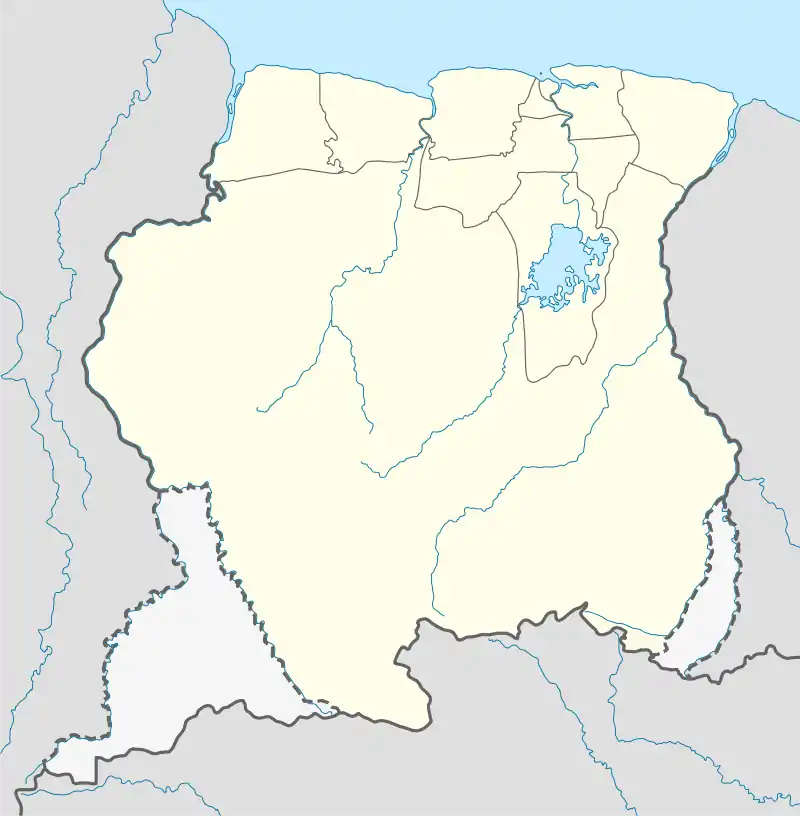| Fort Sommelsdijk | |
|---|---|
| Part of Suriname | |
 Soldiers at Fort Sommelsdijk (1884) | |
 Fort Sommelsdijk | |
| Coordinates | 5°51′32″N 54°51′55″W / 5.8590°N 54.8653°W |
| Site history | |
| Built | 1686 |
| Built by | Society of Suriname |
Fort Sommelsdijk was a fort in Suriname built in 1686 at the confluence of the Commewijne and Cottica rivers. Later it was used as a mission post and hospital. In 1870, it lost its function and was only used a military outpost. In the 21st century, the fort was taken over by nature.[1]
History
In 1683, Cornelis van Aerssen van Sommelsdijck became the first Dutch governor of Suriname.[2] He built a plantation near the confluence of the Commewijne and Cottica rivers.[3][1] On 7 March 1685, the Court of Policy decided to build a fort at the location, and construction started in 1686. The fort was named after van Aerssen van Sommelsdijck.[1]
On 10 October 1712, Jacques Cassard captured the Meerzorg plantation for France, and threatened Paramaribo across the Suriname River.[4] The governor and the councillors fled to Sommelsdijk from where they negotiated a ransom for the colony.[5] In 1715, it was decided to strengthen Sommeldijk.[1]
In 1745, France threatened war on the Netherlands as part as of the War of the Austrian Succession,[6] therefore, it was decided to build Fort Nieuw-Amsterdam at the confluence of the Suriname and the Commewijne River in order to better protect the plantations.[7] In 1748, it was decided to abandoned Sommelsdijk as a fort,[8] and only use it as a military outpost.[1]
In 1785, the Moravian Church received permission to reuse the fort as a missionary post. In 1789, a hospital was established at the location. The mission post was abandoned in 1818, and the hospital closed in 1870.[1]
References
- 1 2 3 4 5 6 "Fort Sommelsdijk op de samenvloeiing van Commewijnerivier / Cotticarivier". Surinamese National Archive (in Dutch). Archived from the original on 12 March 2009. Retrieved 17 January 2022.
- ↑ "Cornelis van Aerssen van Sommelsdijck". Suriname.nu (in Dutch). Retrieved 17 January 2022.
- ↑ J.D. Herlein (1718). Beschryvinge van de volk-plantinge Zuriname (in Dutch). Leeuwarden: Meindert Injema. p. 51.
- ↑ Jan Jacob Hartsinck (1770). Beschryving van Guiana, of de wilde kust in Zuid-America (in Dutch). Amsterdam: Gerrit Tielenburg. p. 682.
- ↑ P. Geyl (1959). "Geschiedenis van de Nederlandse stam" (in Dutch). Amsterdam: Wereldbibliotheek N.V. p. 260.
- ↑ John Besseling (2017). "Joan Jacob Mauricius (1692-1768): bouwstenen voor een biografie". Mededelingen van de Stichting Jacob Campo Weyerman (in Dutch). Retrieved 17 January 2022.
- ↑ "Fort Nieuw Amsterdam - Suriname". Wereld van de haai (in Dutch). Retrieved 17 January 2022.
- ↑ "Surinaamsche Almanak voor het Jaar 1831". Digital Library for Dutch Literature (in Dutch). 1830. p. 256. Retrieved 17 January 2022.